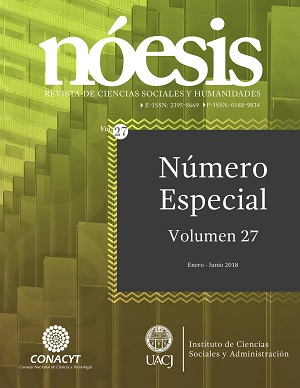PSR and DPSIR indicators for analysis of sustainability in the municipality of Cihuatlan, Jalisco, Mexico
Main Article Content
Abstract
This article aims to analyze the sustainable development of the municipality of Cihuatlán in the South Coast region of the state of Jalisco (Mexico) using Pressure-State-Response (PSR) and Driving Forces-Pressure-State-Impact-Response (DPSIR) indicators. The work was done emphasized three sectors: forestry, agriculture and tourism. The information was obtained from official documents, participation in workshops and interviews with relevant actors, the latter helped to identify environmental problems and made a subjective assessment of their status. The main problem identified was inadequate waste management, other pressures are related to ecosystem degradation and biodiversity, vulnerability to climate change and air pollution. Regarding responses, highlighted the poor application of existing laws on environmental management, as well as the low importance of protection and respect for the environment, particularly among local public officials. The originality lies in the proposal of a set of municipal indicators that must be quantified in order to know how to achieve sustainable development.
Downloads
Article Details

This work is licensed under a Creative Commons Attribution-NonCommercial-ShareAlike 4.0 International License.
References
Arias, Fabio. 2006. Desarrollo sostenible y sus indicadores. Revista Sociedad y Economía, 11: 200-229.
Brundtland Gro, Mansour Ahalid, Susanna Agnelli, Saleh Al-Athel, Bernad Chidzero, Lamine Fadika, et al. 1987. Our common future: The World commission on environment and development. Oxford: Oxford University Press.
Caire, Georgina. 2007. Retos para la gestión ambiental de la cuenca Lerma-Chapala: Obstáculos institucionales para la introducción del manejo integral de cuencas. En El manejo integral de cuencas en México, compilado por Helena Cotler. Ciudad de México: Secretaría de Medio Ambiente y Recursos Naturales, 195-212.
Chevalier, Serge, Robert Choiniere y Lorraine Bernier. 1992. User guide to 40 community health indicators. Ottawa: Community Health Division, Health and Welfare.
Chirino, Esteban, Juan Abad y Juan Bellot. 2008. Uso de indicadores de Presión-Estado-Respuesta en el diagnóstico de la comarca de la Marina Baixa, SE, España. Ecosistemas, 17(1): 107-114.
Eizenberg, Efrat y Yosef Jabareen. 2017. Social sustainability: A new conceptual framework. Sustainability, 9(1): 1-16. http://dx.doi.org/10.3390/su9010068
Escalera, Luciano. 2013. Los principales actores de la producción científica internacional en el estado de Jalisco: 1970-2010. Tesis de licenciatura en biblioteconomía, Ciudad de México: Escuela Nacional de Biblioteconomía y Archivonomía.
European Environment Agency. 1999. Environmental indicators: Typology and overview. Copenhague: EEA.
Fraser, Evan, Andrew Dougill, Warren Mabee, Mark Reed y Patrick Mcalpine. 2006. Bottom up and top down: Analysis of participatory processes for sustainability indicator identification as a pathway to community empowerment and sustainable environmental management. Journal of Environmental Management, 78(2): 114-127. https://doi.org/10.1016/j.jenvman.2005.04.009
Gallopín, Gilberto. 1996. Environmental and sustainability Indicators and the concept of situational indicators. A systems approach. Environmental Modeling & Assessment, 1(3): 101-117. https://doi.org/10.1007/BF01874899
Glavic, Peter y Rebeka Lukman. 2007. Review of sustainability terms and their definitions. Journal of Cleaner Production, 15: 1875-1885. http://dx.doi.org/10.1016/j.jclepro.2006.12.006
González, María y María de Lázaro y Torres. 2005. Indicadores básicos para la planificación de la sostenibilidad urbana local. Revista Bibliográfica de Geografía y Ciencias Sociales, 10(586): s.p.
Guttman, Edith, Carlos Zorro, Adriana Cuervo y Juan Ramírez. 2004. Diseño de un sistema de indicadores socio ambientales para el distrito capital de Bogotá. Bogotá: Naciones Unidas, Santiago de Chile.
IIEG. 2016. Cihuatlán, diagnóstico del municipio. Cihuatlán: Instituto de Información Estadística y Geográfica.
INEGI. 2010. Censo de población y vivienda. Ciudad de México: Instituto Nacional de Estadística y Geografía.
INEGI. 2015. Encuesta intercensal. Ciudad de México: Instituto Nacional de Estadística y Geografía.
Ivars, Josep. 2001. Planificación y gestión del desarrollo turístico sostenible: propuestas para la creación de un sistema de indicadores. Alicante: Instituto Universitario de Geografía, Universidad de Alicante.
Mogheir, Yunes y Ihab Lubbad. 2008. Development of monitoring and evaluation system for wastewater issues in Palestine. International Journal of Environment and Pollution, 33(1): 54-71. http://dx.doi.org/10.1504/IJEP.2008.018464
Neri, Ana, Patricia Dupin y Luis Sánchez. 2016. A pressure–state–response approach to cumulative impact assessment. Journal of Cleaner Production, 126: 288-298. https://doi.org/10.1016/j.jclepro.2016.02.134
OCDE. 1993. Core set of indicators for environmental performance reviews: A synthesis report by the group on the state of the environment. Paris: Organización para la Cooperación y el Desarrollo Económico.
OCDE. 1998. Toward sustainable development: Environmental Indicators. Paris, Francia: Organización para la Cooperación y el Desarrollo Económico.
Orenstein, Daniel y Dalit Shach-Pinsley. 2017. A comparative framework for assessing sustainability initiatives at the regional scale. World Development, 98: 245-256. http://dx.doi.org/10.1016/j.worlddev.2017.04.030
Ott, Wayne. 1978. Environmental indices: Theory and practice. Michigan: Ann Arbor Science.
Pannell, David y Steven Schilizzi. 1999. Sustainable agriculture: A matter of ecology, equity, economic efficiency or expedience? Journal of Sustainable Agriculture, 13(4): 57–66. http://dx.doi.org/10.1300/J064v13n04_06
PED 2030. 2007. Plan Estatal de Desarrollo Jalisco 2030. Guadalajara, México: Gobierno del Estado de Jalisco.
Pires, Alex, Jordi Morato, H. Peixoto, Verónica Botero, L. Zuluaga y Apolinar Figueroa. 2016. Sustainability assessment of indicators for integrated water resources management. Science of Total Environment, 578: 139-147. http://dx.doi.org/10.1016/j.scitotenv.2016.10.217
Quiroga, Rayén. 2007. Indicadores ambientales y de desarrollo sostenible: avances y perspectivas para América Latina y el Caribe. Santiago de Chile, Chile: Comisión Económica para América Latina y el Caribe.
Rapport, David y Anthony Friend. 1979. Towards a comprehensive framework for environmental statistics: a stress-responseapproach=Projet d'établissement d'un système général d'information sur l'environment au Canada: l'approche agression-réaction. Ottawa, Canadá: Minister of Supply and Services Canada.
SEMARNAT. 2006. Estrategia de educación ambiental para la sustentabilidad. Ciudad de México, México: Secretaría de Marina y Recursos Naturales.
Sun, Tengteng, Wenpeng Ling, Guangsheng Cheng, Pupu Guoa y Ying Zeng. 2016. Wetland ecosystem health assessment through integrating remote sensing and inventory data with an assessment model for the Hangzhou Bay, China. Science of the Total Environment¸ 566(1): 627-640. https://doi.org/10.1016/j.scitotenv.2016.05.028

